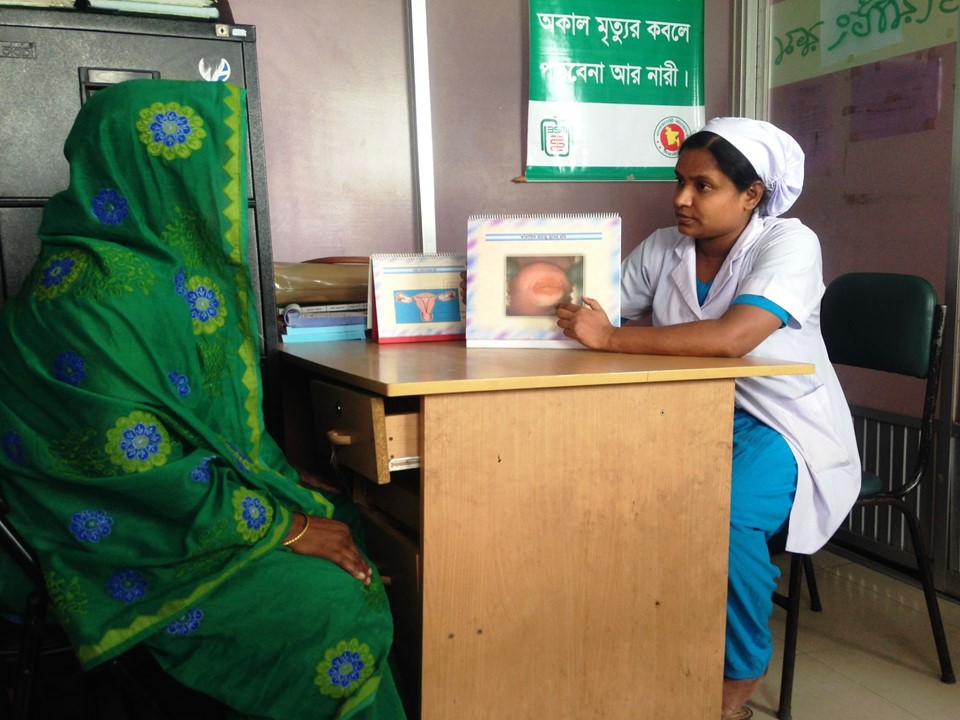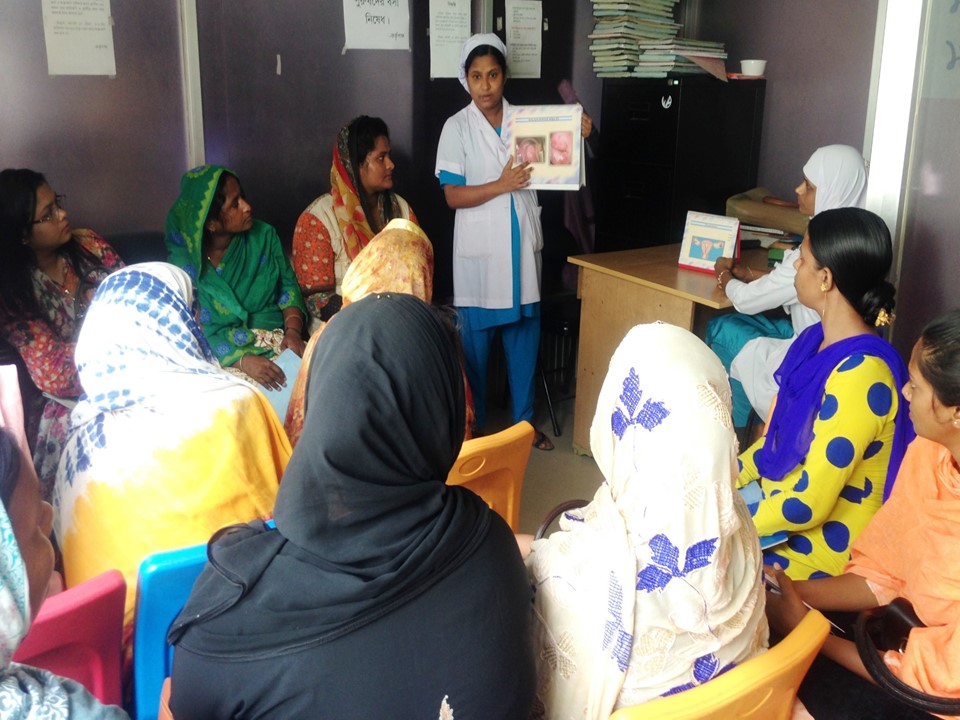|
Using Human Papillomavirus (HPV) detection tests for cervical cancer screening and managing HPV-positive women – a practical guide / Activity 5Procedure to collect samples for HPV testing – Counselling of a woman undergoing HPV testing |   | .png)
Click on the pictures to magnify and display the legends
|
Counselling for cervical cancer screening and management of screen-positive women:
Counselling before screening is crucial, because it helps women make an informed decision. Women attending a screening clinic should be educated about the importance of cervical cancer screening, the test procedures, possible test outcomes, and the availability of simple and safe treatment options for cervical abnormalities. It is important to explain that a negative HPV test result implies no risk of cervical cancer in the next 5–10 years but that the test should be repeated at regular intervals.
Because most of the women attending screening clinics are without symptoms, it is important that they are counselled appropriately about the implications of the test results. Lack of adequate information may lead to a negative psychological reaction to a positive HPV test result and subsequent non-compliance with diagnosis and treatment. Effective counselling facilitates an improvement in the compliance of women not only with screening but also with any subsequent follow-up visits. Furthermore, face-to-face interaction helps women overcome the fear and embarrassment of a gynaecological check-up.
Question 1: What is counselling ?
Counselling is a face-to-face, two-way confidential interaction between a health-care provider and a woman on any issue related to health, such as cervical cancer screening and further management of screen-positive women, to help them make informed decisions and participate in health care.
Question 2: Why is counselling necessary?
- Most of the women attending screening clinics do not have any symptoms and need counselling on the implications of the test results.
- Women need to be educated about cervical cancer prevention (which includes screening for women and HPV vaccination of adolescent girls), attending screening even when they are asymptomatic (for early detection), and treatment of precancer so that cervical cancer can be prevented.
- Women may feel embarrassed about gynaecological check-ups, and many women experience fear related to the screening tests and procedures.
Counselling is necessary to:
- educate and inform women by providing accurate and appropriate information about cervical cancer prevention, screening tests, and further management of screen-positive women;
- clarify the woman’s doubts and concerns (and those of her partner or family member) related to cervical cancer screening and further treatment, if any;
- help the woman make informed, voluntary decisions according to her needs and situation;
- facilitate the woman’s actions on the decisions beneficial for her health before and after screening;
- build the woman’s confidence to participate in health care according to the informed decisions.
Counselling has several benefits:
- Individual face-to-face counselling by counsellors or health-care providers motivates women to get screened and to follow further management advice when needed.
- Adequate and appropriate information about the implications of not getting screened, having a positive screening test result, and the availability of safe and effective treatment can help women overcome negative feelings.
- Counselling ensures women’s compliance with services, improves their morale, and raises their self-esteem by enabling them to decide for themselves.
- Counselling can provide assurance to women with negative screening test results that they have a very low risk of precancer or cancer in the immediate future.
- Women who have a normal screening test result (screen-negative women) need to be informed about the need to return for repeat screening after the recommended interval.
Question 3: What are the characteristics of a good counsellor?
A good counsellor must do the following:
- Introduce themselves and ask the woman to sit comfortably.
- Address the woman by her name.
- Assure the woman of privacy and confidentiality. Allow the woman’s partner or family member to be present during the counselling session if the woman desires this.
- Be a good listener. Listen to what the woman has to say, and encourage her to express her concerns without interrupting her.
- Encourage the woman to ask questions, and give clear answers in a calm, reassuring manner.
- Ask more open-ended questions (i.e. questions that begin with who, what, where, when, why, or how) to encourage the woman to give a more complete and meaningful response. Ask closed-ended questions (i.e. questions that require a yes, a no, or a single-word answer) occasionally, if required during the communication.
- Use simple language that the woman will easily understand and not find difficult or embarrassing. Rephrase the message in simpler, lay terms if the woman has not understood any point.
- Avoid using medical and technical terms as much as possible.
- Talk to the woman in a friendly manner, develop a cordial relationship, and encourage two-way communication.
- Paraphrase what the woman has said, to ensure that the counsellor has understood her correctly.
- Ask the woman to repeat key messages discussed during the interaction from time to time, to confirm that she is understanding the messages correctly.
- Use supportive non-verbal communication, such as nodding, smiling, and maintaining eye contact, in a culturally appropriate manner throughout the interaction.
- Be sensitive to any cultural and religious considerations.
- Use pictures, models, and charts to explain concepts during the interaction.
- Give the woman written information (if available and appropriate) to remind her of instructions.
- Be aware that low levels of information and poor communication between women and health-care providers can lead to negative psychological consequences in women with abnormal screening test results (screen-positive women).
Question 4: What are the different strategies for counselling?
- There are three different strategies for counselling, which a counsellor or health-care provider can use when counselling women for cervical cancer screening. These are:
- Counselling individual women:
- This is one-to-one counselling between the counsellor or health-care provider and the woman.
- It ensures privacy and allows the counsellor to respond to the personal questions and specific needs of the woman.
- Counselling couples:
- This involves the woman’s partner or spouse being present during the counselling session if the woman desires this.
- This helps counsellors to clarify the couple’s doubts and concerns about cervical cancer prevention, screening, and treatment.
- It helps to open communication between the couple.
- It helps the partner or spouse to provide support to the woman during decision-making about screening and treatment, if required.
- Counselling groups of women:
- This involves counselling a group of women either in the clinic waiting area or in the community.
- It helps to educate groups of women and raise awareness and mobilize them for screening.
- This strategy is used to make optimal use of time by creating general awareness in women about cervical cancer, screening tests, and simple treatment procedures if the screening test results are positive.
- It helps to address common myths and misconceptions related to cervical cancer, screening, and treatment.
- Each strategy has advantages and disadvantages, and counsellors and health-care providers need to identify when it is appropriate to use each strategy or a combination of two or more strategies.
- A combination of these strategies can be used, depending on national protocols, clinic volume, staffing, and the woman’s preference.
Myths and misconceptions related to cervical cancer, screening, and treatment:
There are many myths and misconceptions about the causes, prevention, and treatment of cervical cancer. These myths and misconceptions can prevent women from seeking cervical cancer screening and management services. Understanding the most common myths and misconceptions will help the counsellor or health-care provider to effectively address these by providing accurate information to women and their family members during counselling sessions.
Below is an animation presenting a collection of myths and misconceptions about cervical cancer and the corresponding facts that the counsellor or health-care provider can use to address them during a counselling session. Click here to download the myths and misconceptions about cervical cancer.
Steps of pre-screening counselling:
Begin a counselling session by greeting the woman (and her husband or partner, if present) respectfully and introducing yourself. Help the woman feel relaxed by ensuring adequate privacy and starting with general pleasantries (e.g. “How are you doing today?”). Provide information about the following:
- Location of the cervix in the woman’s body
- Cause of and risk factors for cervical cancer
- Importance of screening for cervical cancer
- The HPV test and how it is performed
- HPV test results and their implications
- Further tests or procedures that the woman will have to undergo if the test result is positive
- Available simple and safe treatment methods, if required
- Importance of follow-up visits even after treatment
- If the test result is negative, it is important that the test is repeated at regular intervals as advised, to prevent cervical cancer.
Avoid using scientific terms as much as possible. Encourage the woman to ask questions, and respond to her concerns (if any) in a reassuring manner. Where these are available, use models or visual aids (in the form of posters, flipbooks, and leaflets) as a means of communication. Reassure the woman that her privacy will be maintained during the examination and the outcomes of the screening test will be kept confidential. Obtain the woman’s consent for screening, if this is indicated by the programme guidelines. End the counselling session by thanking the woman (and her husband or partner, if present). The next section describes the steps of history taking before screening.
|  |  |
|
| 
